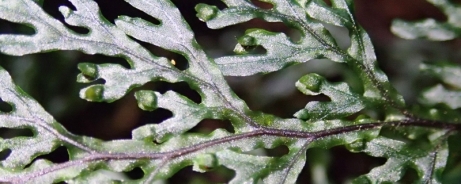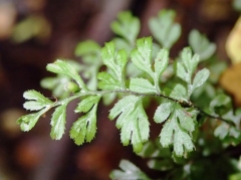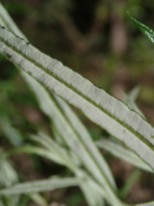A few night time visits to the park to get a better idea of the night flying insects that live in Tarra-Bulga have been reaping rewards. Here are just a few highlights of what is flying or crawling about our tall forests. All sightings are being uploaded to our project on www.bowerbird.org.au where they can hopefully be identified and then placed on the the Atlas of Living Australia and become a permanent record in their searchable online database.
Tag: Identification
Asplenium’s (The Spleenworts)
Asplenium’s or Spleenworts are a very interesting group of ferns and at Tarra Bulga there are three species that can be found. One of them is common in Rainforest gullies while the other two are harder to find. It is not hard to tell each one apart although there may me some hybridisation happening between two of the species which can be confusing.
Mother Spleenwort – Asplenium bulbiferum subsp. gracillimum
This is common in the park mainly in rain forest gullies, it grows as epiphytes on tree and fern trunks as well as on shady banks, and among rocks. It can be potentially confused with other ferns that grow in this habitat such Shiny or Leathery Shield-fern. An impressive feature of this fern is its ability to reproduce via bulbils that can form on the tips of the fronds, giving rise to its common name “mother” as well as the Latin one. A good way to distinguish it from other ferns is to locate the linear to oblong shaped sori on the margins of the underside of the fertile fronds and to look for the many tiny brown scales on the surface of the stem and the fronds.
Weeping Spleenwort – Asplenium flaccidum subsp. flaccidum
Weeping Spleenwort is very uncommon in the Park, hopefully there is more hidden away in some gully that we don’t know about, but we only really know about one living plant that currently exists here. Compared to Mother Spleenwort it has linear to oblong pinnules that are not lobed. The pinnules are widely spaced on the long Weeping Fronds. It only has a few scattered scales.
Necklace Fern – Asplenium flabellifolium
Necklace fern is unlikely to be found in the Cool Temperate Rainforest areas in Tarra Bulga, it is more often in sheltered shady spots (e.g.) along road cuttings in more exposed sections of the park. It is more common at lower altitudes in the district, e.g. in the Warm Temperate Rainforest of Macks Creek. It is easily distinguished from the other local Asplenium species with its small slender green fronds having fan shaped leaflets (pinnae), forming what could be described as a necklace.
Possible Hybrid???
According to some sources Aspleniums are known to hybridise across species. Several plants that I photographed along the Fern Gully Track at Bulga Park, seem to have features somewhere intermediate between Mother Spleenwort (Asplenium bulbiferum) and Weeping Spleenwort (Asplenium flaccidium).

Filmy Ferns
Filmy Ferns are a feature of the wet gullies and rainforests in Tarra Bulga, they are usually found as epiphytes growing on the trunks of trees and other ferns, especially Soft tree-fern (Dicksonia antarctica) as well as rocks and steep embankments . There are five different species known to occur in the park and although they are small and delicate, with a bit of practice it is easy enough to learn to tell the difference between each species. Four of them belong to the same genus (Hymenophyllum). Along with the Filmy ferns there are many species of Mosses and Liverworts that flourish in similar moist sheltered locations.
Click on the Galleries for Closer Views and Photo Descriptions
Austral Filmy-fern Hymenophyllum australe
This fern is dark green and not particularly shiny. It is common and easy to identify by the wing which is several millimetres wide and extends all the way along the central wiry stem from the tip of the frond to the base (stipe) where it is attached. It has lots of spore producing sori at the tips of the fronds. The sori have 2 lips and they often present in pairs.
Shiny Filmy-fern Hymenophyllum flabellatum
This is another very common fern found in the rainforest gullies. As indicated by its common name it is very shiny and it is a lighter green than the Austral Filmy-fern. The stem (stipe) does not have a wing and has a tuft of hairs at the base. The pinnae (ends of the fronds) often form a fan shape. The sori (spore producing bits) at the tips of the frond segments are wider than the rest of the leaf.
Common Filmy-fern – Hymenophyllum cupressiforme
Common Filmy-fern is easily found and identified by serrated margins of its outer fronds. It has large spore producing sori which are located close to the main stem (rachis) of the frond. Alpine Filmy-fern (Hymenophyllum pelatum) also has serrated margins of it frond segments (pinnae) but it has never been found in the Tarra Bulga.
Narrow Filmy-fern – Hymenophyllum rarum
As its Latin name suggests this fern is the hardest to find of all the local species. It will often grow among Common – Filmy fern (e.g. Along the East-West track in the Tarra Valley picnic area) and superficially looks similar. As its common name suggests it is narrow, It has a narrow wing along its main stem which may cause confusion with Austral Filmy-fern, but a clear distinguishing feature is the the V shape made by the veins at the base of the indusium (tissue protecting the spores) at the tips of fertile frond segments. Click on the Gallery below for a better view.
Veined Bristle-fern – Polyphlebium venosum
Is the only species of the 5 ferns not in the genus Hymenophyllum. It is very common in the same habitats as the other occur. It is distinguished by its very delicate pale green shiny fronds (only one cell thick). Tiny branched veins are clearly visible on the narrow fronds. The fertile fronds have a trumpet shaped spore cover (indusium).
Fungi Season
This time of the year (Late Autumn) is the best time for seeing the interesting array of Fungi present in Tarra Bulga National Park. A diversity of fungi species (in addition to the towering trees and lush ferns and mosses and the wildlife) make a visit well worth the effort.
Most of the photos shown in the gallery below were taken in two recent strolls around the Rainforest walks at both Bulga Park and the Tarra Valley, with the latter site having the most fungi on show. Tarra Valley has had a long history of being an interesting destination for fungi observation, Back In the 1950’s, Kara Healey (Victoria’s first female ranger) collected around 160 species of fungi from the Park area, two previously un-described species she collected were even named in her honor.
Fungi Map are holding their 7th Biennial iNational Conference in Gippsland later this month and the participants are spending a full day at the Park on Monday May 21st. More information can be found via this link. https://www.fungimap.org.au/index.php/fungimap7fullproginfo Maybe you can go along and learn a few things and then be able to assist us with identifying some of the species feature in this gallery!
Hypolepis – Ground Ferns
One of the trickiest groups of Ferns to identify locally are a group of Ground ferns in the Genus Hypolepis. There are three different species recorded in the park but I have only ever found two of them which are Hypolepis glandulifera (Downy Ground-fern) and Hypolepis rugulosa (Ruddy Ground-fern). Without looking carefully these ferns can be mistaken for Bracken because they have a similar growth habit with fronds popping up from a spreading underground rhizome.
Hypolepis rugulosa (Ruddy Ground-fern) seems to be more common locally at higher altitudes in the Park (e.g. Wet Forest areas around Balook). It seems to like disturbed areas at the sides of roads and tracks. Its main feature for identification in the field is the reddy-brown colour of the frond stems (Stipes).
Hypolepis glandulifera (Downy Ground-fern) I have found mostly at lower altitudes, especially along waterways (e.g. Tarra River and Macks Creek). Its frond stems (Stipes) are usually a pale green colour. It usually has lots of fine hairs along the stems and the new fronds are often sticky to the touch as a result of the small glands on the tips of many of the hairs. If you have a hand lens or use a digital camera with a macro setting you can see that there is a little triangular tooth close to the sori on the underside of fertile fronds. This fern was formerly known as Hypolepis punctata.
Hypolepis muelleri (Harsh Ground-fern) is also listed in Park’s flora records for the but I have yet to find any. It can be identified by the presence of tiny hairs growing in the Sori on the underside of the fertile fronds.
Blechnums: Hard and Soft Water Fern’s
Another post in our series for people wanting to know more about the fern species in Tarra Bulga National Park and how to identify them. Here we look at two more species of Blechnum. Hard Water-fern (Blechnum wattsii) and Soft Water-fern (Blechnum minus).
Blechnum wattsii – (Hard Water-fern) is much more common than the Soft Water-fern at Tarra Bulga and is found in both Cool Temperate Rainforest and Wet Schlerophyll forest areas. It has tough dark green fronds, a key feature is that the lower leaves (pinnae) on each stem (rachis) are only slightly smaller than the others.
Blechnum minus – (Soft Water-fern) is locally more restricted in its distribution and mainly confined to the banks of water-bodies. It’s fronds are a lighter shade of green and the margins of the pinnae are more undulating or wavy. A key feature of their identification is that the lower leaves (pinnae) on each stem is are much shorter than the rest and they are also widely spaced apart.
Both species are dimorphic meaning that the fertile fronds that contain the spores are different to the regular fronds, for both of these species they are a lot more slender than the regular fronds.
Related Posts
Local Cassinias
This is the time of year when most of the daisy species in Tarra Bulga are in flower. A number of species look quite similar and a bit of knowledge is often needed to tell one from another.They are all medium shrubs with narrow linear leaves and similar looking cauliflower like flower-heads.
One group are the Cassinias’ there are three separate species and all of them occur in the more open and exposed sections of the park rather in the shaded and protected gullies
Cassinia aculeata – (Common Cassina or Dogwood) has the the shortest and narrowest leaves of the three. If you look underneath the leaves you can see that they are curled over at the edges. Another distinguishing feature is that the new flowers are sometimes pink rather that white.
Cassinia longifolia – (Shiny Cassinia) has broader and longer leaves and the new leaves are noticeably shiny and sticky to touch. The underside of the leaves are covered in short dense hairs and the vein down the middle is very prominent.
Cassinia trinerva – (Three-veined Cassinia)Has leaves that are also broader and longer than Common Cassina, they are quite soft and not shiny or sticky. They have a big vein running down the middle of the leaf and two smaller veins that run a millimetre or two inside the leaf margins.
Ozothamnus ferrugineus (Tree Everlasting) is a fourth species that can be confused with the Cassinia’s as it is a similar size and has similar leaves. It’s leaves are around the same size as Cassinia longifolia (Shiny Cassinia) but its leaf margins are usually a little wavy. With close examination the flowers are clearly different to Cassinias, they have little bracts around the individual florets.



























































































